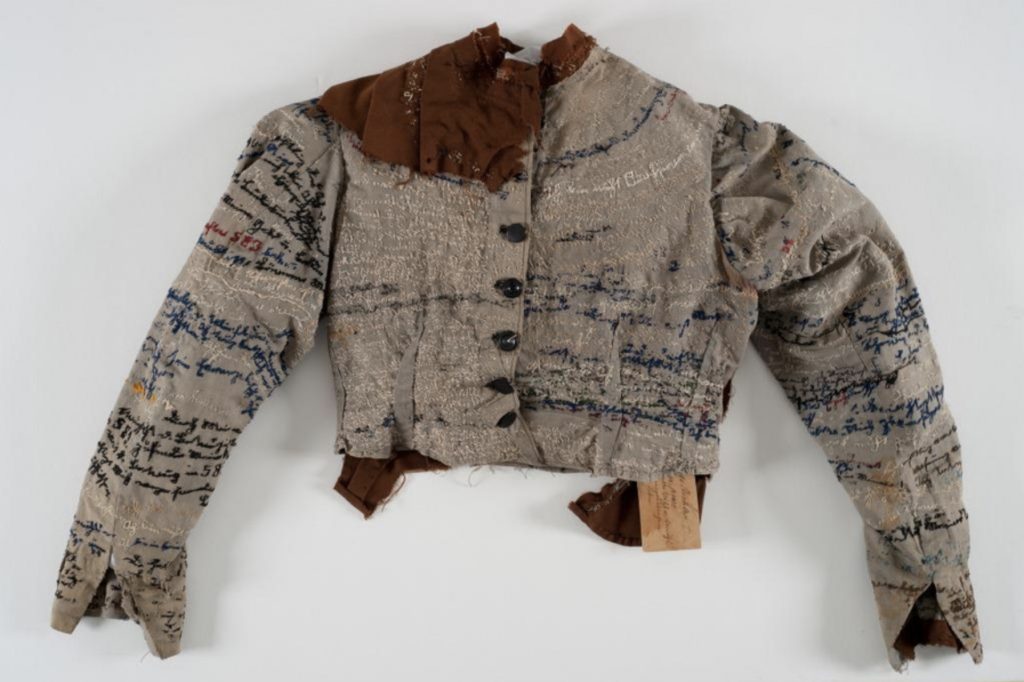Agnes Richter, born in 1844, came from Dresden, Germany, and worked as a seamstress. At 49, she was admitted to Dresden’s City Lunatic Asylum, having been diagnosed as suffering from a persecution complex. Though found to be mentally stable, she was institutionalized for two years, then transferred to the Hubertusberg Psychiatric Institution and put under guardianship.
Her condition then rapidly deteriorated. In “Threads of Life: A History of the World Through the Eye of a Needle”, Clare Hunter describes what happened next:
“It was there that she took up a needle and thread and began to embroider text on the grey green linen of her regulation asylum jacket, re-fashioned to her own shape. Using different coloured thread and an antiquated German cursive script, she furiously stitched outrage in overlapping words, jagged letters, repeated assertions of self, Ich (I) sewn over and over again; emphatic avowals of existence…It is not set out in neat lines but rather words, phrases, and sentences are crowded together at odd angles across the cloth.”
Agnes sewed almost exclusively on the inside of the jacket, as if to keep the words close to her skin. She died in 1918. The asylum kept the jacket with the note she’d pinned to it, reading: “memories of her life in seams of every piece of washing and clothing.” The text has never been decoded but the jacket — sweat-stained, molded to the shape of Agnes’s body, and a silent, anguished cry — has through the years been exhaustively pored over, photographed, studied, and marveled at.
“Agnes’s Jacket: A Psychologist’s Search for the Meaning of Madness,” by Gail A. Hornstein, combines investigative journalism, academic psychology, and human curiosity to explore the inner world of those who suffer from mental illness.
“What if their ‘ravings’ contain important information?” she asks. “Just because they’re difficult to decipher doesn’t mean we shouldn’t try to make them out.”
She’s referring to the text sewn on Agnes’s jacket, but she takes that same question into her inquiry as she sits with, speaks with, and listens to those who have been diagnosed with mental illness and are forging their own unique approach.
What she finds almost completely upends her clinical training. She finds creative, inventive individuals who are seeking their own ways of healing apart from, or in some cases in conjunction with, conventional therapy and drug treatment.
Hornstein lives in England where to date this approach is far more widespread than in the U.S., but she travels here as well as all over Europe to discover and describe similar movements.
The one-size-fits-all psychiatric diagnosis simply doesn’t make sense, she learns. Without devolving into a rant, she points out the symbiotic relationship between big pharma and the medical profession and notes that in many cases drugs have hindered rather than helped.
Hornstein finds whole worlds she barely knew existed: of those who hear voices, for example. She learns that thousands of advocates, activists, and quiet sufferers have banded together in support groups to discuss this condition, tell their stories, and offer mutual support.
She notes the role trauma so often plays in mental illness. She finds people who are courageously fully functioning in the world while also managing almost unimaginably heavy psychic crosses.
And most of all, she emphasizes that for centuries those with mental illness have been silenced, ignored, abused. Over and over, she emphasizes the longing of those who suffer the daily anguish of excruciating loneliness and isolation simply to be seen, to be gazed upon, to be heard.
One female patient, quoted in “The Plea for the Silent,” a 1957 document put out by two members of British Parliament, observed: “Nothing has been of greater help to me than this — that there was still one person in the world to whom I could say anything that I might wish, without being made to feel that I had no real rights, little intelligence, and no finer feeling.”
Could people who have been dismissed as psychotic have stories that actually bear in a unique way on our spirits and souls?
Former patient James Melton spent 10 years in Britain in a state of semi-catatonia. He’s since recovered and speaks with extraordinary insight, intelligence, and poetry of that time.
At one point he heard the call of invisible birds. Hornstein asked, “Were they calling directly to you? Could you tell what they were saying?”
“They seemed to come to console,” Melton replied. “There was something about them that I came to think of as good. As if one were being visited by the mercy of things...It’s as if in that last place of fragility and pain there is some answering voice from what — how do you say? From the universe, from the heart of being, from the human condition. As if there’s a mercy at the heart of our human condition that these bird calls gave a voice to.”
Perhaps Agnes Richter was trying to give voice to that mercy as well, poring mutely with needle and thread over her indecipherable jacket: a bird sheltered in the nest she made her life’s work to build.
“Not a sparrow falls but what he knows.” And “Suffer the little children to come unto me — for the kingdom of heaven belongs to such as these.”

